Maybe you’ve been wondering how to swim faster for months or even years, but you haven’t found a satisfactory answer.
Well, you’re not alone. Many people who want to improve their swimming skills encounter this problem for various reasons.
That’s why I have put together this article, which highlights some of the problem areas and offers solutions.
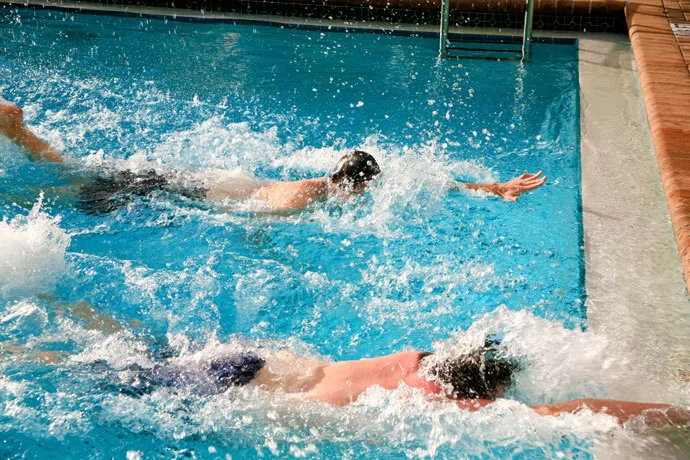
Train Smarter, not Harder
Many coaches emphasize conditioning while training their athletes. The length and intensity of workouts are gradually increased, and as the athlete’s body adapts and gets stronger, lap times drop.
However, while the general level of the athlete’s fitness improves, if there are deficiencies in the athlete’s technique, progress is often limited.
The reason for this is that swimming efficiently requires a lot of technique, as the human body has evolved to move on land, not in the water.
Now, some gifted swimmers will always make progress, even with little technical guidance, but the reality is that the vast majority of swimmers will benefit as much from improving their stroke mechanics as from physical conditioning.
With this in mind, two approaches must be pursued to improve the swimmer’s technique and to enable him to swim faster:
- The drag the swimmer creates in the water needs to be reduced.
- The propulsion the swimmer generates in the water needs to be increased.
The six principles discussed below can all be classified under these two approaches.
Decreasing Drag
It is often underestimated how important it is to keep drag to a minimum when swimming.
The reason for this is that water is much denser than air. As a consequence, the drag in the water increases by the square of the speed at which we move in the water.
If we take into account that the amount of power we can exert in the water is limited and that, on the other hand, reducing drag is more of a matter of skill than of power, it becomes clear that this is an area where substantial improvements are possible.
With this in mind, we can formulate the first principles that will allow us to swim faster.
Principle #1: Improving Your Balance
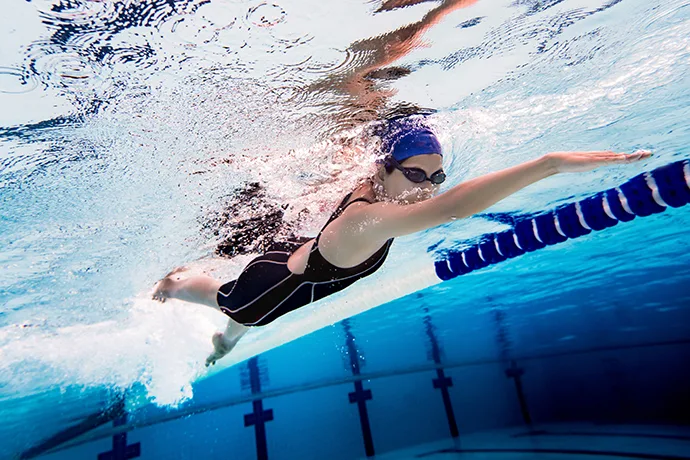
One of the first and best ways to decrease drag is to improve balance. This means that you try to stay as horizontal as possible while moving through the water.
When you do this, you disrupt the smallest amount of water molecules on your way, resulting in reduced drag.
For example, there are front crawl swimmers who first lift their head forward before turning it to the side to breathe.
When they do this, they lose their balance, and their hips and legs sink. As a result, their body is less streamlined and creates more drag as it moves through the water.
They also have to kick harder to keep their legs up, which wastes energy.
Please note that in the breaststroke and the butterfly stroke, things are a bit different, as these strokes rotate around an imaginary axis that runs through your hips, and therefore you do not remain horizontal over the entire stroke cycle.
Principle #2: Swimming Taller
The next way to decrease drag is to make yourself as tall as possible in the water.
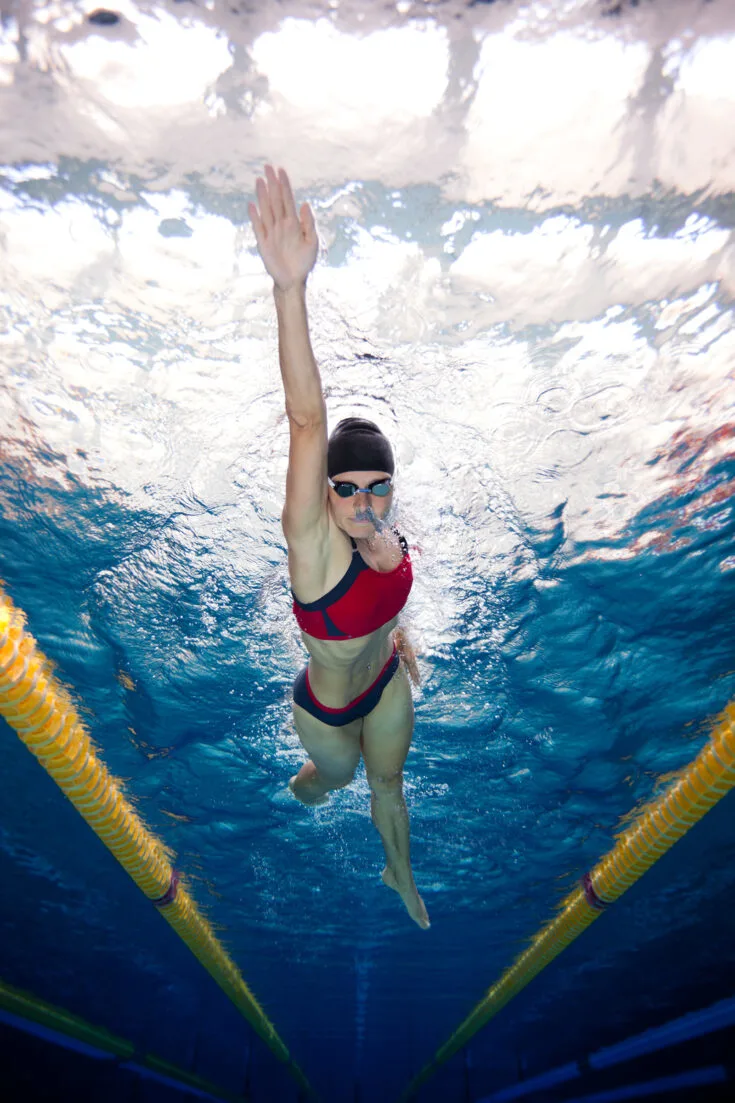
The theory is that, with the same mass, a long and tapered object moving through the water creates less turbulence than a short and blunt object. Marine engineers have used this principle for centuries.
To swim taller in the front crawl stroke, your recovering arm enters early in the water, shortly after it has passed your head.
You also make sure that you fully extend your recovering arm forward underwater before starting the downsweep and catch.
Principle #3: Compact and Efficient Kick
An efficient kick is important for fast swimming, albeit less important than commonly assumed.
For world-class swimmers, the kick in the front crawl contributes up to 10 percent to propulsion, while the arm stroke contributes the rest.
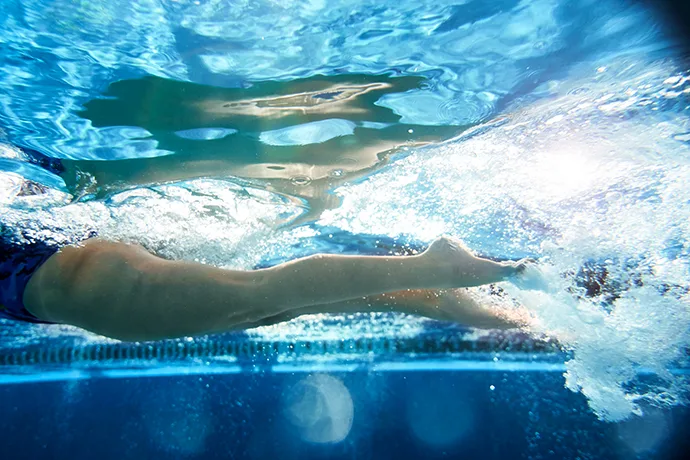
For an efficient flutter kick, you need to perform fast and compact movements.
Your feet should only break the water surface slightly; they should not move below the body line so your kick stays mostly in the shadow of your body.
Otherwise, unnecessary drag will be generated, slowing you down.
Improving Propulsion
Once you have reduced drag to a minimum, you can work on improving your propulsion. Again, this is mainly achieved by improving the mechanics of your stroke, not by building larger muscles.
Principle #4: Swim More on the Sides
One way to improve your propulsion is to roll sufficiently from side to side with each arm pull.
If you roll from side to side while pulling with your arms, your body is in a better position to engage the chest and back muscles in addition to the shoulder muscles.
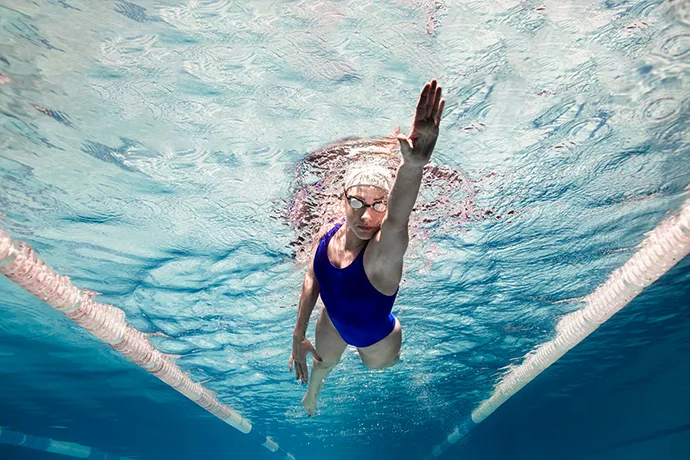
However, swimming on your sides can feel a bit odd in the beginning and, therefore, requires some practice.
Principle #5: Using Your Core Muscles
Once you have acquired the habit of rolling from side to side with each arm stroke, the next step is also to engage your core muscles.
The synergy between your core, back, shoulder, and chest muscles allows you to put a lot of energy in your arm stroke without tiring your shoulders too quickly.
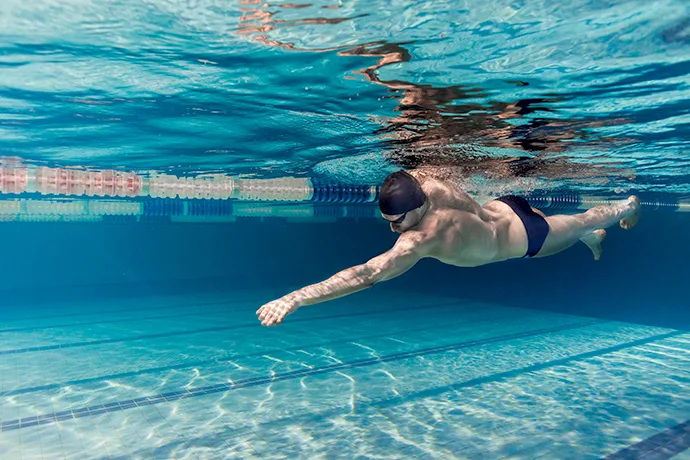
It is a little like a baseball pitcher when he throws the ball:
First, his body turns back. Then, his hips make a forward turn, which is directed through his upper body into his shoulder, arm, hand, and finally into the ball, with acceleration occurring at each stage.
Once you have integrated this technique, you will be able to swim longer and faster and tire less quickly because your core, back, and chest muscles have more endurance than those in your shoulders.
Principle #6: Anchoring Your Arms
The last principle we will explain in this article on how to swim faster is the anchoring of the arms in the water.
Before pulling your arm backward in the water, you need to wait until your forearm and hand are in line and pointing downward, with the inside of your forearm and palm facing backward.
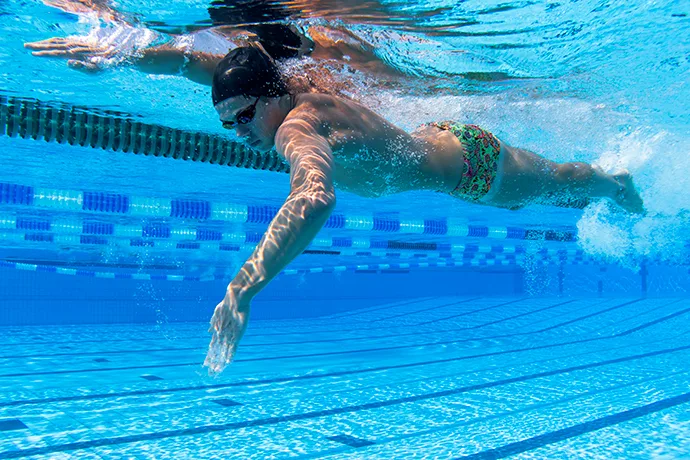
At this moment, the elbow is high in the water and located above the hand, which is why this swimming technique is called the high-elbow catch.
Once your arm is in this position, you can move it backward as a single unit, similar to a large paddle, and create a lot of propulsion.
Conclusion
There you have it: six principles on how to swim faster. If you follow them, you should see your swimming times improve.
You can begin to integrate these principles into your swimming technique by following our series of exercises for the front crawl stroke.
Have fun!

Fridaous Adegbola
Wednesday 28th of September 2022
I really enjoy this lesson and it really help me in improving
Swimmer04
Monday 8th of February 2021
Hi, I really like the pictures and want to print some for my wall. Where did you get them? Thank you!
Christophe
Monday 8th of February 2021
Hi,
If memory serves well, I bought them from BigStock: https://www.bigstockphoto.com/
hansel
Wednesday 7th of August 2019
I can swim a 2k in around 50 minutes but i want to increase my speed. I usually breathe onto one side every swim stroke and have a 2 kick. Do i require to decrease my drag and improve my pull to get faster
Abhishek Peje
Wednesday 17th of October 2018
Article is very helpful to me
Mariama
Wednesday 19th of April 2017
Hello,
Where I lived before, we didn't have sports in schools so I learned how to swim at an early age but only started swimming competitively at the age of 15.
We don't have a pool at school so we only practice 2 days a week for an hour for 3 months, and I will be going to college fall of 2018 and I want to be really fast before that.
Right now I swim the 50 freestyle in 63 seconds and I want to get at least to 30 or 25 seconds before 2018, any suggestions on how I can do that?
I plan on practicing a lot during summer but I am not sure what kind of workout I should do.
Thanks.
Christophe
Sunday 23rd of April 2017
Hi Mariama,
I keep hearing good things about the "Swim Speed" series by Sheila Taormina, you might check it out.
Good luck,
Christophe